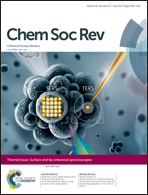Electromagnetic theories of surface-enhanced Raman spectroscopy
Abstract
Surface-enhanced Raman spectroscopy (SERS) and related spectroscopies are powered primarily by the concentration of the electromagnetic (EM) fields associated with light in or near appropriately nanostructured electrically-conducting materials, most prominently, but not exclusively high-conductivity metals such as silver and gold. This field concentration takes place on account of the excitation of surface-plasmon (SP) resonances in the nanostructured conductor. Optimizing nanostructures for SERS, therefore, implies optimizing the ability of plasmonic nanostructures to concentrate EM optical fields at locations where molecules of interest reside, and to enhance the radiation efficiency of the oscillating dipoles associated with these molecules and nanostructures. This review summarizes the development of theories over the past four decades pertinent to SERS, especially those contributing to our current understanding of SP-related SERS. Special emphasis is given to the salient strategies and theoretical approaches for optimizing nanostructures with hotspots as efficient EM near-field concentrating and far-field radiating substrates for SERS. A simple model is described in terms of which the upper limit of the SERS enhancement can be estimated. Several experimental strategies that may allow one to approach, or possibly exceed this limit, such as cascading the enhancement of the local and radiated EM field by the multiscale EM coupling of hierarchical structures, and generating hotspots by hybridizing an antenna mode with a plasmonic waveguide cavity mode, which would result in an increased local field enhancement, are discussed. Aiming to significantly broaden the application of SERS to other fields, and especially to material science, we consider hybrid structures of plasmonic nanostructures and other material phases and strategies for producing strong local EM fields at desired locations in such hybrid structures. In this vein, we consider some of the numerical strategies for simulating the optical properties and consequential SERS performance of particle-on-substrate systems that might guide the design of SERS-active systems. Finally, some current theoretical attempts are briefly discussed for unifying EM and non-EM contribution to SERS.

- This article is part of the themed collections: Celebrating a Century of Excellency in Chemistry at Xiamen University and Surface and tip enhanced spectroscopies


 Please wait while we load your content...
Please wait while we load your content...